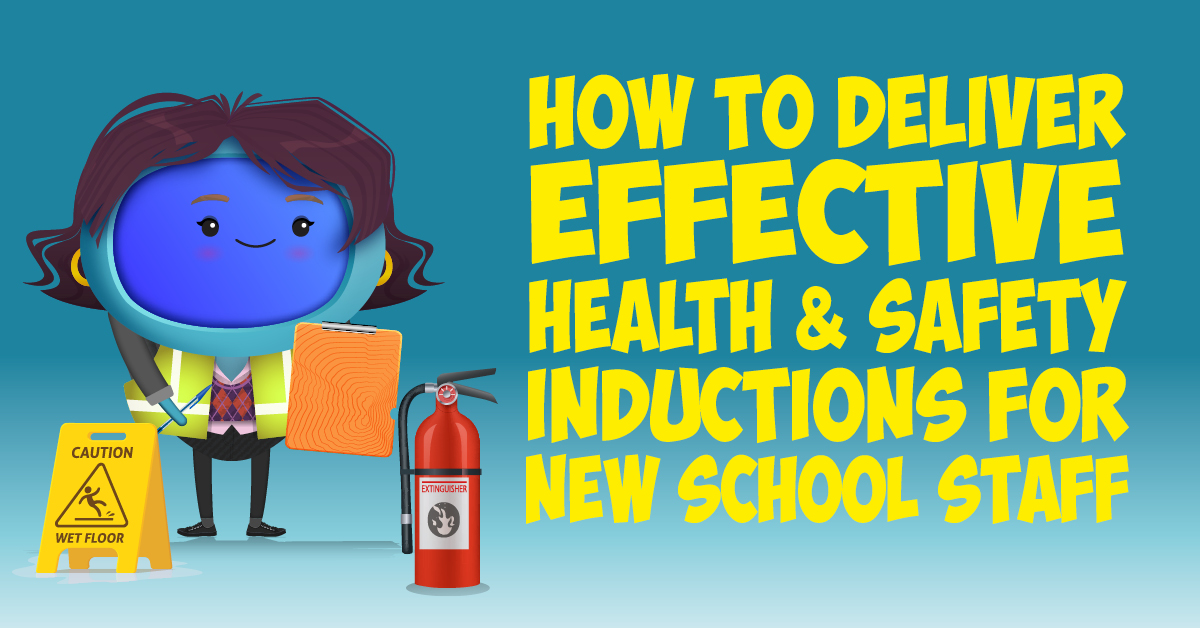Asbestos is a killer. If you breathe in materials containing asbestos, you have a high risk of reduced life expectancy.
Asbestos is not just a problem of the past, although now banned in the UK, it can be present today in any building built or refurbished before the year 2000. So, it’s highly likely your school or college falls in that time window unless you’re in a spangly new build.
So, you’ve got a duty of care to protect your teachers, visitors, pupils and public from this carcinogen, and you must have measures in place to manage asbestos hazards in your school effectively.
This asbestos management in school guide is here to help. We delve into the following key topics:
Who is responsible for managing asbestos in schools?
What are the laws around managing asbestos in schools?
The dangers of asbestos in schools
What damage can asbestos in schools do?
Managing asbestos in your school
Where to start: Asbestos management in schools
Top tips on getting asbestos inspection ready
Asbestos checks: for when the HSE visit
The main pitfalls during asbestos checks in schools
What is asbestos? Asbestos meaning
Asbestos is a naturally occurring fibrous mineral. Seen as a ‘wonder material’, the government labelled it as a versatile material and it was mined for its useful properties. Asbestos was mixed into building materials and woven into fabrics to create strong, heat-resistant, and fire-proof insulation.
Asbestos was used extensively as a building material in Great Britain from the 1950s through to the mid-1980s for a variety of purposes, typically fireproofing and insulation.
Any school building built before 2000 can contain asbestos. When asbestos fibres are inhaled, they can cause serious diseases. To ensure that risks from asbestos in buildings are managed, the Control of Asbestos Regulations 2006 places duties on those responsible for the maintenance or repair of school premises.
Asbestos in school buildings
Most school and college buildings contain asbestos. If managed actively and safely, the presence of asbestos in your school or college should not pose a risk to occupants. Poor management of asbestos however can pose serious health risks.
Undamaged, sealed materials will not release fibres. But if materials containing asbestos are disturbed or damaged, asbestos fibres can be released into the air and breathed in by school building occupants. This is more likely to happen as asbestos materials age and deteriorate.
The activities most likely to lead to the disturbance of asbestos materials in schools and colleges are building and maintenance work. Depending on their nature and location, asbestos materials could also be disturbed through vandalism and other everyday impacts on the asbestos material.
Asbestos is most likely to be found in insulating boards, lagging and asbestos cement products in roofing or walls plus sprayed coatings (Artex to you and me!) used as fire protection and acoustic control for structural steelwork.
You may also be surprised to hear that asbestos can also be found in plastics, such as floor tiles, sink pads, cisterns, and toilet seats!
Who is responsible for managing asbestos in schools?
Those responsible for maintenance and repair - known as ‘dutyholders’ – are accountable for protecting others, who work or use the school premises, from asbestos exposure.
In some schools, the responsibility for maintenance or repair is shared, for example between a local authority as the employer and the school. In other schools, the responsibility may fall solely to a governing body as the employer. All ‘dutyholders’ must ensure that any asbestos-containing materials (ACMs) are managed properly.
What are the laws around managing asbestos in schools?
The Control of Asbestos Regulations 2012 came into force on 6 April 2012. Failure to comply with these regulations is a criminal offence. The Health and Safety Executive (HSE) investigates incidents where dutyholders fail to manage the risks and takes enforcement action where appropriate.
Types of asbestos in schools
There are actually different colours of asbestos:
- White asbestos (Chrysotile) – this is the most commonly used as it’s found in roofing materials and cement
- Brown (Amosite)
- Blue (Crocidolite)
All asbestos is odourless, tasteless and its colour is indistinguishable unless inspected under a microscope so it’s possible to be exposed to its menace whilst being blissfully unaware of it burrowing into your chest!
The dangers of asbestos in schools
Asbestos causes around 5,000 deaths every year according to the HSE, which is more than the number of people killed on the road! So, although the fibres are small they can certainly have a significant negative impact when they are disturbed.
When materials that contain asbestos are disturbed or damaged, fibres are released into the air. When these fibres are inhaled, they can cause serious diseases. These diseases won’t affect your school’s occupants immediately; they often take a long time to develop, but once diagnosed, it is often too late to do anything. This is why it is important that you protect yourself and those in your school now.
What makes asbestos in schools more dangerous than other minerals is that it doesn’t break down into small grains, but rather the tiny fibres we mentioned earlier. These are thinner than human hair which makes them brilliant candidates for building a blockage inside our lungs, causing gradual breathing difficulties.
Areas within your school buildings that are particularly high risk include:
- Asbestos pipe lagging
- Asbestos insulating board (AIB)
- Perforated AIB ceiling tiles
- Doors with AIB panels
Remember, although these are the most likely uses and places where asbestos will be found, asbestos was used in many other materials. If in doubt, it is safer to presume that a material contains asbestos unless there is strong evidence that it does not.
What damage can asbestos in schools do?
Inhalation of asbestos fibres can lead to various dangerous lung conditions, including:
- Mesothelioma: Mesothelioma is a cancer which affects the lining of the lungs (pleura) and the lining surrounding the lower digestive tract (peritoneum). It’s almost exclusively related to asbestos exposure and by the time it is diagnosed, it’s almost always fatal.
- Asbestos-related lung cancer: Asbestos-related lung cancer is the same as lung cancer caused by smoking and other causes. It’s estimated that there is around one lung cancer for every mesothelioma death according to the HSE.
- Asbestosis: Asbestosis is a serious scarring condition of the lung that normally occurs after heavy exposure to asbestos over many years. This condition can cause progressive shortness of breath, and in severe cases can be fatal.
- Pleural thickening: Pleural thickening is generally a problem that happens after heavy asbestos exposure. The lining of the lung (pleura) thickens and swells. If this gets worse, the lung itself can be squeezed and can cause shortness of breath and discomfort in the chest.
Asbestos isn’t an instant killer, but it can stay in your system and slowly damage your organs for 10-60 years so unlike quitting smoking or going on a diet, you can’t reverse the effects.
Asbestos is now notorious as a serious health and safety hazard.
Managing asbestos in your school
If you have carpenters, plumbers, electricians, builders, decorators, or any other person coming into your school or college that may come into close contact with asbestos and damage its structure through hammering, drilling, or cutting, you need to be aware of the risks and keep everyone in and visiting your school safe from its fibrous jaws.
Young people are also at greater risk of danger as they’re still developing, but that doesn’t mean your older teachers, helpers etc are off the hook either!
Where to start: Asbestos management in schools
The HSE are prioritising asbestos management in schools and have announced that schools must be ready for imminent asbestos inspections, so it’s important to be prepared so you’re not caught out if you’re paid a visit.
Here are our insider tips on how to prepare for when the call comes in or the HSE arrive at your school reception.
Your asbestos survey
If you’ve not already got an asbestos survey, this is definitely the place to start. Without a survey you won’t know if there’s any asbestos on your site, what condition it’s in, and if there’s any action needed, so it’s a fundamental first step.
We’re all for saving money for your school by doing as much as possible yourself but asbestos is such a specialist area that we’d really recommend getting a good quality survey carried out by an accredited UCAS UK surveyor. Getting these foundations right is critical to effectively and safely managing asbestos on your school site so it’s worth the investment.
The surveyor (make sure you see evidence of appropriate experience and training!) will carry out a thorough assessment of your site, really examining everything in minute detail.
The outcome of this survey will provide you with information on what Asbestos Containing Materials (ACMs) you have in your school building that your building users may come into contact with in the normal school day-to-day running of things.
If you’re going to undertake maintenance, refurbishment, or any type of work within your school or college, even if it’s just installing IT cabling, you should not ideally perform any of these until you’re sure the people carrying out the work won’t be encountering asbestos. So, in this situation, you’ll need a Maintenance/Refurbishment Survey in addition to your day-to-day asbestos survey.
The HSE have a handy asbestos management for schools checklist that will assist you in reviewing asbestos management arrangements. It takes you through a range of questions to check whether suitable precautions are in place, and you can record further action required.
Top Tips On Getting Asbestos Inspection Ready
Now you’ve got your asbestos survey in place that’s a great start, but there are some other critical elements you need in place to ensure you’re fully compliant.
- Risk Assessment: A good asbestos survey will also include an assessment of the risk of asbestos present on your site and recommended actions to undertake. The assessment will identify whether any asbestos on your site is problematic or not, investigate whether it could be damaged, where is it located, and which type of asbestos it is.
- Management/Action Plan: It’s all well and good having a thorough survey and risk assessment in place but what are you then going to do about it? Your action plan will identify measures needed to offset and mitigate any risks that have been flagged up. You need to be looking at this at least every six months, checking the identified asbestos to see if there has been any deterioration or damage. A good survey will often take photographs of the asbestos material so when you come to reinspect you can take further photographs to evidence any changes.
- Staff Briefings: The HSE may choose to call your school site rather than just turn up at reception, so they may speak to anybody on your school site. If the staff member they speak to doesn't seem clear on what asbestos is or what plans are in place to manage it, that’s going to be a red flag to the HSE. So, talk to your staff in the office or anyone who is likely to answer the phone, give them a rundown, and brief them on your asbestos survey and management plan. Ensure all your asbestos documents are kept electronically and physically on a shelf somewhere so that everyone has access.
- Asbestos Training: There could potentially be asbestos in any part of your school site, so everyone must have at least a basic awareness of what asbestos is, where it may be lurking and the dangers it can pose if disturbed.
So, you’ve got all your documentation, plans, training, and briefings, in place but what is it that the HSE are specifically going to ask when they come knocking or call your reception?
Asbestos checks: for when the HSE visit
- Do you have an asbestos management plan and if so, please provide a copy?
All non-domestic premises built before the year 2000 must have an asbestos management plan.
- Has asbestos been identified at your site? Please provide up-to-date records.
Asbestos that’s identified is usually detailed in an asbestos register.
- Are all asbestos-containing materials in a good condition? Please provide evidence.
Asbestos in a good condition means that it is being managed properly.
- Has the risk of people being exposed to asbestos been assessed? Please provide a copy of these assessments.
This usually comes in the form of a priority risk assessment. These assessments look at the risk of people being exposed to asbestos and not just the asbestos material itself.
The good news is if you’ve got a robust asbestos survey, risk assessment and action plan in place for your school, none of the above will cause a problem. But it’s key to make sure you’re prepared ahead of that knock on the door or call to reception.
The main pitfalls during asbestos checks in schools
A few years back the HSE ran some asbestos inspections across a range of schools and issued 20 improvement notices.
There were some common areas the schools needed to make improvements to be fully compliant. Here we share the key areas they tripped up on so you can ensure you avoid them when it’s your turn for inspection.
- Lack of an effective asbestos survey
- The survey isn’t easily accessible/staff don’t know where it is
- No management plan off the back of the survey
- Lack of an asbestos risk assessment
- No asbestos awareness training
What next?
Take a look at our Free Be Asbestos Ready Toolkit – it contains everything you need to swot up on asbestos including our awareness course, asbestos materials checklist, how to prepare for an HSE inspection, how to ensure you’re compliant and how to spot asbestos in your school. It’s your one-stop shop for all things asbestos!
Download Your Free Be Asbestos Ready Toolkit
Want to see if iAM Compliant is right for your school? Book a quick no-obligation demo with the team to discuss your particular needs.



